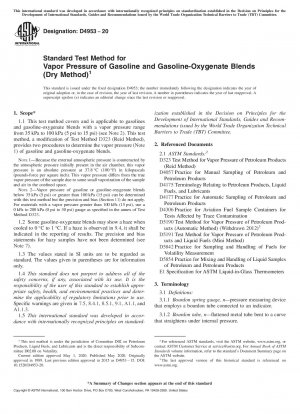ASTM D4953-20
Standard Test Method for Vapor Pressure of Gasoline and Gasoline-Oxygenate Blends (Dry Method)
- Standard No.
- ASTM D4953-20
- Release Date
- 2020
- Published By
- American Society for Testing and Materials (ASTM)
- Latest
- ASTM D4953-20
- Scope
- 1.1 This test method covers and is applicable to gasolines and gasoline-oxygenate blends with a vapor pressure range from 35 kPa to 100 kPa (5 psi to 15 psi) (see Note 2). This test method, a modification of Test Method D323 (Reid Method), provides two procedures to determine the vapor pressure (Note 1) of gasoline and gasoline-oxygenate blends. NOTE 1—Because the external atmospheric pressure is counteracted by the atmospheric pressure initially present in the air chamber, this vapor pressure is an absolute pressure at 37.8 °C (100 °F) in kilopascals (pounds-force per square inch). This vapor pressure differs from the true vapor pressure of the sample due to some small vaporization of the sample and air in the confined space. NOTE 2—Vapor pressure of gasoline or gasoline-oxygenate blends below 35 kPa (5 psi) or greater than 100 kPa (15 psi) can be determined with this test method but the precision and bias (Section 11) do not apply. For materials with a vapor pressure greater than 100 kPa (15 psi), use a 0 kPa to 200 kPa (0 psi to 30 psi) gauge as specified in the annex of Test Method D323. 1.2 Some gasoline-oxygenate blends may show a haze when cooled to 0 °C to 1 °C. If a haze is observed in 9.4, it shall be indicated in the reporting of results. The precision and bias statements for hazy samples have not been determined (see Note 7). 1.3 The values stated in SI units are to be regarded as standard. The values given in parentheses are for information only. 1.4 This standard does not purport to address all of the safety concerns, if any, associated with its use. It is the responsibility of the user of this standard to establish appropriate safety, health, and environmental practices and determine the applicability of regulatory limitations prior to use. Specific warnings are given in 7.5, 8.4.1, 8.5.1, 9.1, A1.1, and A1.1.3. 1.5 This international standard was developed in accordance with internationally recognized principles on standardization established in the Decision on Principles for the Development of International Standards, Guides and Recommendations issued by the World Trade Organization Technical Barriers to Trade (TBT) Committee.
ASTM D4953-20 Referenced Document
- ASTM D323 Standard Test Method for Vapor Pressure of Petroleum Products (Reid Method)
- ASTM D4057 Standard Practice for Manual Sampling of Petroleum and Petroleum Products
- ASTM D4175 Standard Terminology Relating to Petroleum Products, Liquid Fuels, and Lubricants*, 2023-07-01 Update
- ASTM D4177 Standard Practice for Automatic Sampling of Petroleum and Petroleum Products
- ASTM D4306 Standard Practice for Aviation Fuel Sample Containers for Tests Affected by Trace Contamination
- ASTM D5190 Standard Test Method for Vapor Pressure of Petroleum Products (Automatic Method)
- ASTM D5191 Standard Test Method for Vapor Pressure of Petroleum Products (Mini Method)
- ASTM D5842 Standard Practice for Sampling and Handling of Fuels for Volatility Measurement
- ASTM D5854 Standard Practice for Mixing and Handling of Liquid Samples of Petroleum and Petroleum Products
- ASTM E1 Standard Specification for ASTM Thermometers
ASTM D4953-20 history
- 2020 ASTM D4953-20 Standard Test Method for Vapor Pressure of Gasoline and Gasoline-Oxygenate Blends (Dry Method)
- 2015 ASTM D4953-15 Standard Test Method for Vapor Pressure of Gasoline and Gasoline-Oxygenate Blends (Dry Method)
- 2006 ASTM D4953-06(2012) Standard Test Method for Vapor Pressure of Gasoline and Gasoline-Oxygenate Blends (Dry Method)
- 2006 ASTM D4953-06 Standard Test Method for Vapor Pressure of Gasoline and Gasoline-Oxygenate Blends (Dry Method)
- 1999 ASTM D4953-99a Standard Test Method for Vapor Pressure of Gasoline and Gasoline-Oxygenate Blends (Dry Method)
